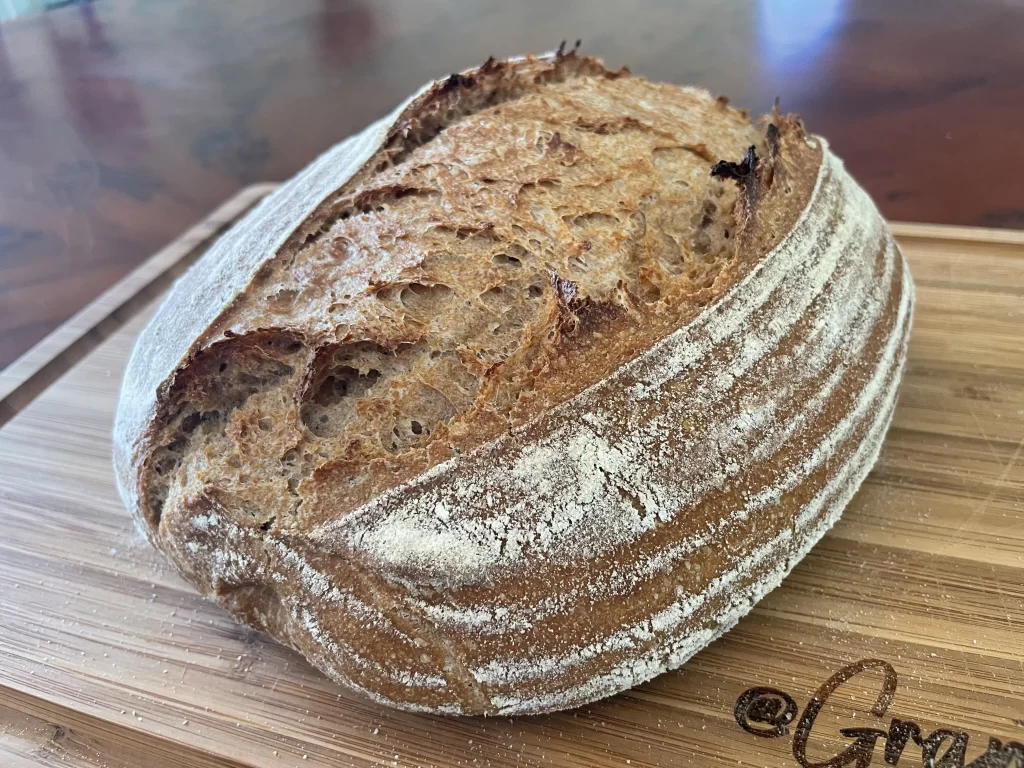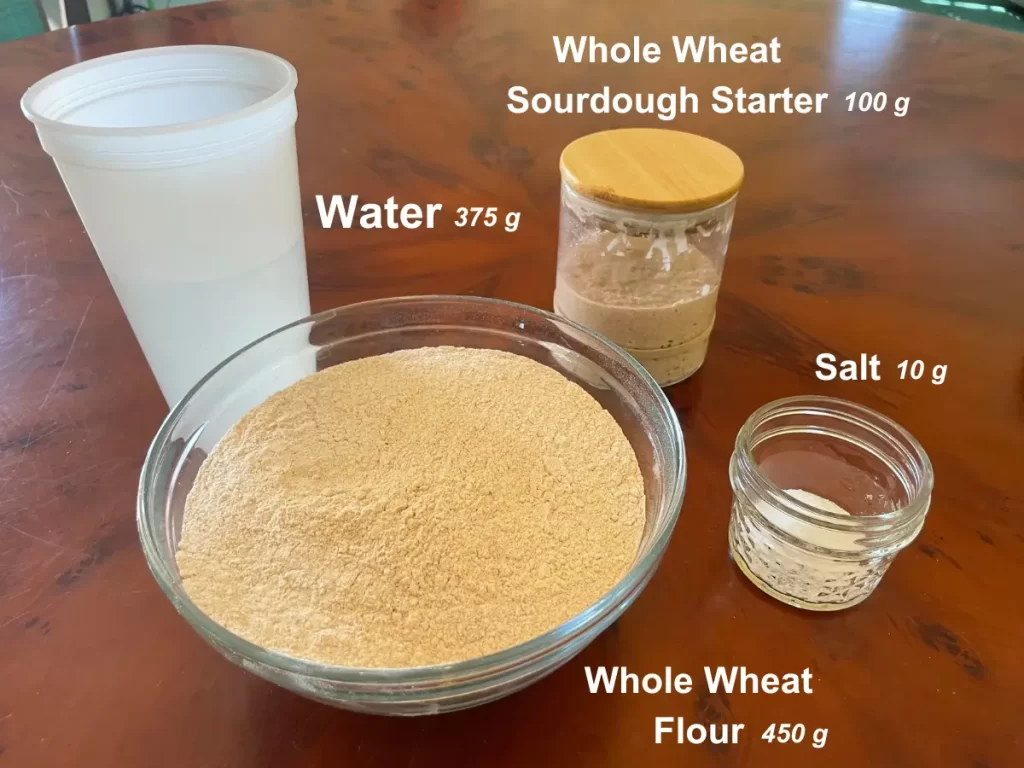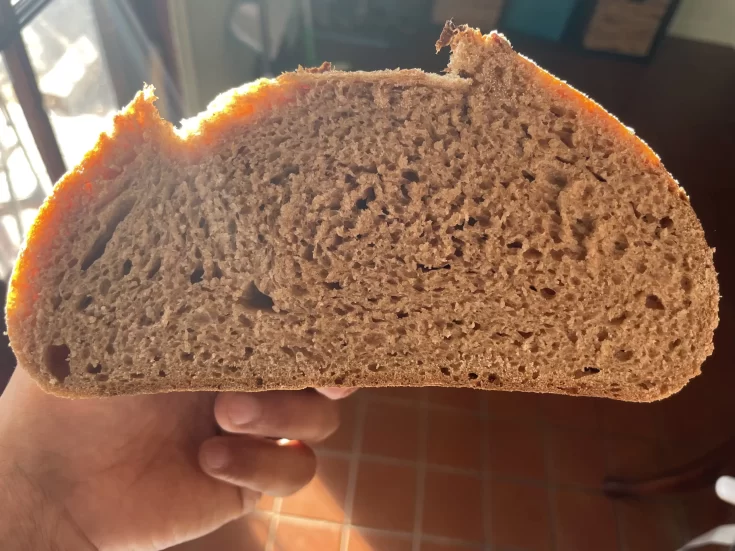This recipe for 100% whole wheat sourdough bread produces a rustic, country-style loaf of bread with a soft and tender crumb and a complex, nutty whole grain flavor.

Why This Recipe Works
You might think it’s impossible to make 100% whole wheat sourdough bread that actually tastes good on the inside and looks good on the outside. That’s why most people only add a portion of whole wheat flour to their dough – they don’t think 100% whole wheat will taste good on its own. But it is completely possible!
The secret to this recipe is to use enough water to sufficiently hydrate the whole grain dough, and to allow the dough to rise long enough so it doesn’t turn out dense or under proofed. With these two techniques baked into this recipe, it’s a sure winner.
Now, let’s talk ingredients.
Ingredients You’ll Need

- Whole Wheat Flour: I used Bob’s Red Mill whole wheat flour for this recipe. King Arthur brand whole wheat flour also works well. You can also use freshly milled whole wheat flour.
- Water: Un-chlorinated tap water or bottled spring water are ideal for this recipe. You may need to use less water or more water depending on how much water your particular flour requires. See the substitutions and additions section below for recommendations on adjusting water content.
- Whole Wheat Sourdough Starter: I took 25 grams of my white sourdough starter and fed it 50 grams of whole wheat flour and 50 grams of white flour. This made a sourdough starter that contained a majority of whole wheat flour. For this recipe, you can follow the same feeding instructions that I did, or use a separate 100% whole wheat starter.
- Salt: Kosher salt, sea salt, or plain table salt are ideal for this recipe.
Note: Check recipe card below for full ingredient amounts and quantities.
Substitutions and Additions
- Adjust Water Content as Needed: Some brands of whole wheat flour, and freshly milled grain flours, will soak up more water than others. After mixing the ingredients for the dough, if you feel like the dough is too dry, try adding 25 grams of water and squeezing it into the dough. Squeeze in water in 25 gram increments until the dough feels/looks like it does in my video tutorial.
How to Make Whole Wheat Sourdough Bread
Ingredients
Whole Wheat Sourdough Starter Feeding
- Sourdough Starter, leftover – 25 grams
- Whole Wheat Flour – 50 grams
- Water – 50 grams
Final Dough
- Whole Wheat Flour – 450 grams
- Water – 375 grams
- Whole Wheat Sourdough Starter – 100 grams
- Salt – 10 grams
100% Whole Wheat Sourdough Bread (Step-by-Step Instructions)
- Take 25 grams of leftover sourdough starter out of the fridge and feed it 50 grams of whole wheat flour and 50 grams of water. Stir the ingredients thoroughly to combine and mark the top of the starter with a rubber band. Cover the starter loosely with a lid and let it rise at room temperature overnight for 8-12 hours, or until it doubles in size.
- The next day mix the water, whole wheat sourdough starter, and salt into same mixing bowl. After using the 100 grams of sourdough starter, there should be about 25 grams of starter remaining in the jar. This can be stored in the fridge until the next time you want to bake. Stir the liquid ingredients together to dissolve the salt and starter into the water.
- Add the whole wheat flour to the mixing bowl. Stir the ingredients together thoroughly to combine. Use a spoon, dough whisk, and/or your hands to mix the dough until most of the dry clumps of flour are gone. If the dough feels too dry, add 25 grams of water to the dough and squeeze it into the dough with your fingers. Add more water in 25 gram increments until the dough feels/looks as dry as it does in my video tutorial.
- When you’re done mixing the dough, cover it up with a kitchen towel or an airtight lid and let the dough rest for 30 minutes. After a half-hour rest, give the dough one set of stretch and folds. Stretch and fold the dough over itself with your hands 10-20 times until the dough starts to feel smoother and to gain strength. Then, cover up the dough and let it rest for another 30 minutes.
- Give the dough two more sets of stretch and folds with a 30-minute rest in between each set. For each set of folds, stretch the dough up into the air and fold it over the top of the dough. Then, give the bowl a quarter turn and start the next stretch and fold. Stretch and fold the dough four times total to complete a full set of stretch and folds.
- After the three sets of stretch and folds are complete, cover up the dough and let it rise at room temperature for 4-6 hours, or until it roughly doubles in size.
- After the first rise, take the dough out of the bowl and place it on the kitchen counter with the sticky side facing down. Shape the dough gently into a ball and then let it rest on the counter for 30 minutes. After the rest period, flip the dough over and shape it into an oval-shaped using the following method: stretch the dough into a square and then fold the left third over them middle third, and then fold the right third over the middle third as well. Then, roll the dough into a tight cylindar and smooth out the edges. (Follow my video tutorial for more detailed visual instructions on this shaping technique.)
- Flip the dough upside down into a banneton basket that has been sprinkled with whole wheat flour. Move the dough into the fridge to ferment overnight in the cold environment for a long final rise (8-24 hours). This long rise will give the dough an extra complex sourdough flavor.
- The next day, 30 minutes before you want to bake, preheat your oven to 450°F (232°C). Place a Dutch oven inside the oven to preheat.
- When the oven is preheated, take the dough out of the fridge and flip it over onto a piece of parchment paper. Rub the excess flour into the dough and score a long slash into the top of the dough with a razor blade or a bread lame.
- Place the dough, parchment paper and all, onto the base of your preheated Dutch oven. Close the lid of the Dutch oven to trap the steam, and allow the bread to bake for 20 minutes with the lid on. Then, remove the lid and continue baking for another 15 minutes with the lid off.
- After baking, let the bread cool on a wire rack for at least an hour before slicing in. This bread is tender and airy, with a closed crumb. The flavor should be complex, nutty, and mildly tangy.

100% Whole Wheat Sourdough Bread

This recipe for 100% whole wheat sourdough bread produces a rustic, country-style loaf of bread with a soft and tender crumb and a complex, nutty whole grain flavor.
Ingredients
Whole Wheat Sourdough Starter Feeding
- Sourdough Starter, leftover - 25 grams
- Whole Wheat Flour - 50 grams
- Water - 50 grams
Final Dough Ingredients
- Whole Wheat Flour - 450 grams
- Water - 375 grams
- Whole Wheat Sourdough Starter - 100 grams
- Salt - 10 grams
Instructions
- Take 25 grams of leftover sourdough starter out of the fridge and feed it 50 grams of whole wheat flour and 50 grams of water. Stir the ingredients thoroughly to combine and mark the top of the starter with a rubber band. Cover the starter loosely with a lid and let it rise at room temperature overnight for 8-12 hours, or until it doubles in size.
- The next day mix the water, whole wheat sourdough starter, and salt into same mixing bowl. After using the 100 grams of sourdough starter, there should be about 25 grams of starter remaining in the jar. This can be stored in the fridge until the next time you want to bake. Stir the liquid ingredients together to dissolve the salt and starter into the water.
- Add the whole wheat flour to the mixing bowl. Stir the ingredients together thoroughly to combine. Use a spoon, dough whisk, and/or your hands to mix the dough until most of the dry clumps of flour are gone. If the dough feels too dry, add 25 grams of water to the dough and squeeze it into the dough with your fingers. Add more water in 25 gram increments until the dough feels/looks as dry as it does in my video tutorial.
- When you're done mixing the dough, cover it up with a kitchen towel or an airtight lid and let the dough rest for 30 minutes. After a half-hour rest, give the dough one set of stretch and folds. Stretch and fold the dough over itself with your hands 10-20 times until the dough starts to feel smoother and to gain strength. Then, cover up the dough and let it rest for another 30 minutes.
- Give the dough two more sets of stretch and folds with a 30-minute rest in between each set. For each set of folds, stretch the dough up into the air and fold it over the top of the dough. Then, give the bowl a quarter turn and start the next stretch and fold. Stretch and fold the dough four times total to complete a full set of stretch and folds.
- After the three sets of stretch and folds are complete, cover up the dough and let it rise at room temperature for 4-6 hours, or until it roughly doubles in size.
- After the first rise, take the dough out of the bowl and place it on the kitchen counter with the sticky side facing down. Shape the dough gently into a ball and then let it rest on the counter for 30 minutes. After the rest period, flip the dough over and shape it into an oval-shaped using the following method: stretch the dough into a square and then fold the left third over them middle third, and then fold the right third over the middle third as well. Then, roll the dough into a tight cylindar and smooth out the edges. (Follow my video tutorial for more detailed visual instructions on this shaping technique.)
- Flip the dough upside down into a banneton basket that has been sprinkled with whole wheat flour. Move the dough into the fridge to ferment overnight in the cold environment for a long final rise (8-24 hours). This long rise will give the dough an extra complex sourdough flavor.
- The next day, 30 minutes before you want to bake, preheat your oven to 450°F (232°C). Place a Dutch oven inside the oven to preheat.
- When the oven is preheated, take the dough out of the fridge and flip it over onto a piece of parchment paper. Rub the excess flour into the dough and score a long slash into the top of the dough with a razor blade or a bread lame.
- Place the dough, parchment paper and all, onto the base of your preheated Dutch oven. Close the lid of the Dutch oven to trap the steam, and allow the bread to bake for 20 minutes with the lid on. Then, remove the lid and continue baking for another 15 minutes with the lid off.
- After baking, let the bread cool on a wire rack for at least an hour before slicing in. This bread is tender and airy, with a closed crumb. The flavor should be complex, nutty, and mildly tangy.
Notes
- Adjust Water Content as Needed: Some brands of whole wheat flour, and freshly milled grain flours, will soak up more water than others. After mixing the ingredients for the dough, if you feel like the dough is too dry, try adding 25 grams of water and squeezing it into the dough. Squeeze in water in 25 gram increments until the dough feels/looks like it does in my video tutorial.
